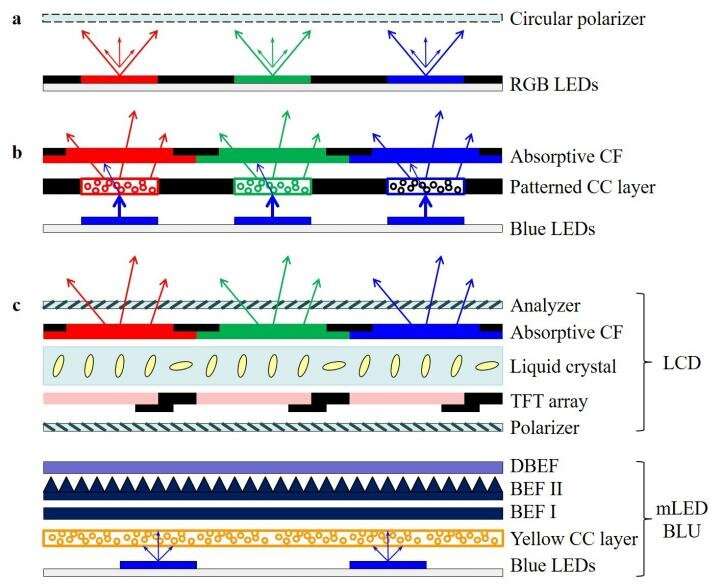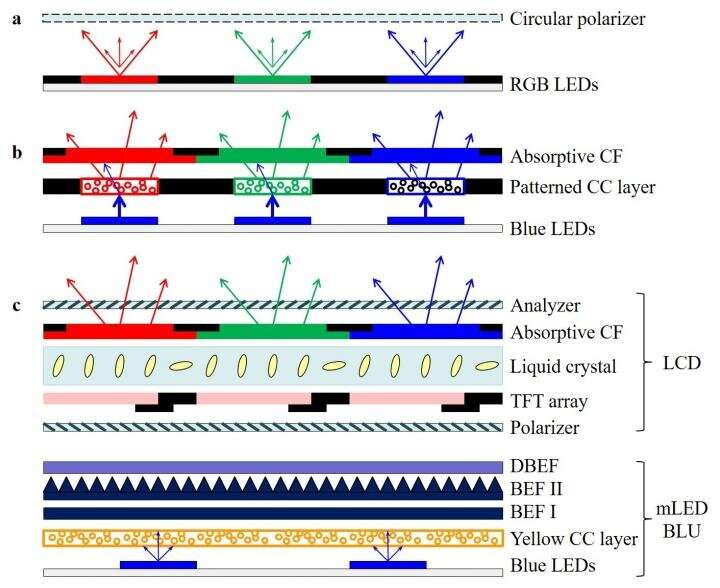Mini-LED, Micro-LED, and OLED displays: Present status and future perspectives

Display technology has become ubiquitous in our daily life; its widespread applications cover smartphones, tablets, desktop monitors, TVs, data projectors, and augmented reality/virtual reality devices. Presently, liquid crystal displays (LCDs) and organic light-emitting diode (OLED) displays are two dominant flat panel display technologies. Recently, inorganic mini-LEDs (mLEDs) and micro-LEDs (μLEDs) are emerging, offering ultrahigh luminance and long lifetimes, that can significantly enhance the dynamic range of LCDs or work as sunlight readable emissive displays. Nevertheless, challenges such as mass transfer yield and defect repair remain, which will undoubtedly affect the cost. "LCD, OLED or μLED: who wins?" has become a topic of heated debate.
In a new paper published in Light: Science & Application, a team of scientists, led by Professor Shin-Tson Wu from the College of Optics and Photonics, University of Central Florida, USA has conducted a comprehensive analysis on the performance of mLED/μLED/OLED emissive displays and mLED backlit LCDs. This group evaluated the power consumption and ambient contrast ratio of each display in depth and systematically compared the dynamic range, motion picture response time, color gamut, and adaptability to flexible and transparent displays. The pros and cons of mLED, μLED, and OLED displays are analyzed, and their future perspectives are discussed.
Prof. Wu's research group has been working on display technologies for decades, from conventional LCDs, OLED displays, quantum dots, to the emerging mLED and μLED displays. This team is devoted to discovering new display materials and devices. "Each display technology has its strengths and challenges: conventional LCDs have long lifetime and low cost, but their contrast ratio and flexibility are limited. OLED displays offer unprecedented dark state and ultrathin profile, but their lifetime and burn-in issues remain to be overcome. Lately, mLED/μLED displays are promising to provide high luminance, long lifetime and compatibility to flexible and transparent displays, but the chip size effect leads the performance on high-resolution-density augmented reality/virtual reality displays to a question, not to mention the low manufacturing yield and high cost. Technology development and manufacturing readiness fall years behind a new method springs. Our motivation is to understand the fundamental limits and develop new approaches for each technology to overcome its obstacles."

"There are several important performance metrics considered: (1) a high dynamic range and a high ambient contrast ratio, (2) high resolution or high ppi to minimize the screen-door effect, (3) a wide color gamut, (4) a wide viewing angle and an unnoticeable angular color shift, (5) a fast motion picture response time to suppress image blur, (6) low power consumption, which is particularly important for battery-powered mobile displays, (7) a thin profile, freeform, and lightweight system, and (8) low cost."
The scientists reported, "After investigations, we found all of these display technologies support superior performance in the abovementioned criteria except for several trade-offs: (1) In achieving high luminance for HDR, mLED-LCDs require careful thermal management, and OLED displays would compromise the lifetime. (2) Transparent display is not the best stage for non-emissive LCDs. (3) The power efficiency and ambient contrast ratio depend on the mLED/μLED/OLED chip size. To achieve the same ambient contrast ratio, mLED backlit LCDs require a comparable power consumption with OLED displays, while the polarizer-free mLED/μLED emissive displays could be 3× more efficient."
They forecast: "In the upcoming years, OLED would continue to grow in smartphone market, while mLED backlit LCD would penetrate into tablets, gaming monitors, computers, and TVs, as the technology gradually matures. In the not-too-distant future, mLED/μLED emissive displays could gradually move toward the central stage as their cost becomes more acceptable."
More information: Yuge Huang et al, Mini-LED, Micro-LED and OLED displays: present status and future perspectives, Light: Science & Applications (2020). DOI: 10.1038/s41377-020-0341-9

















